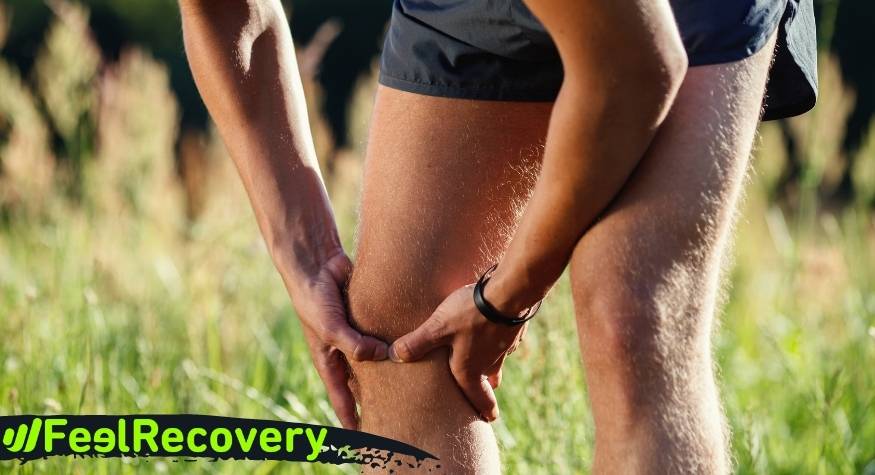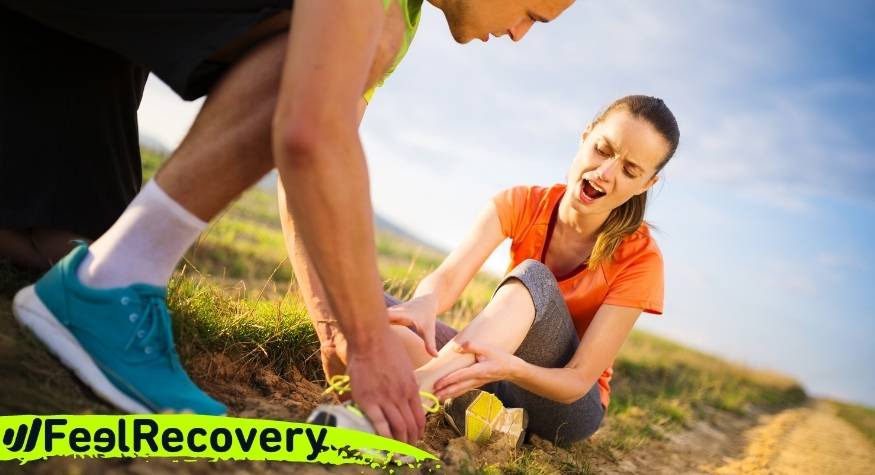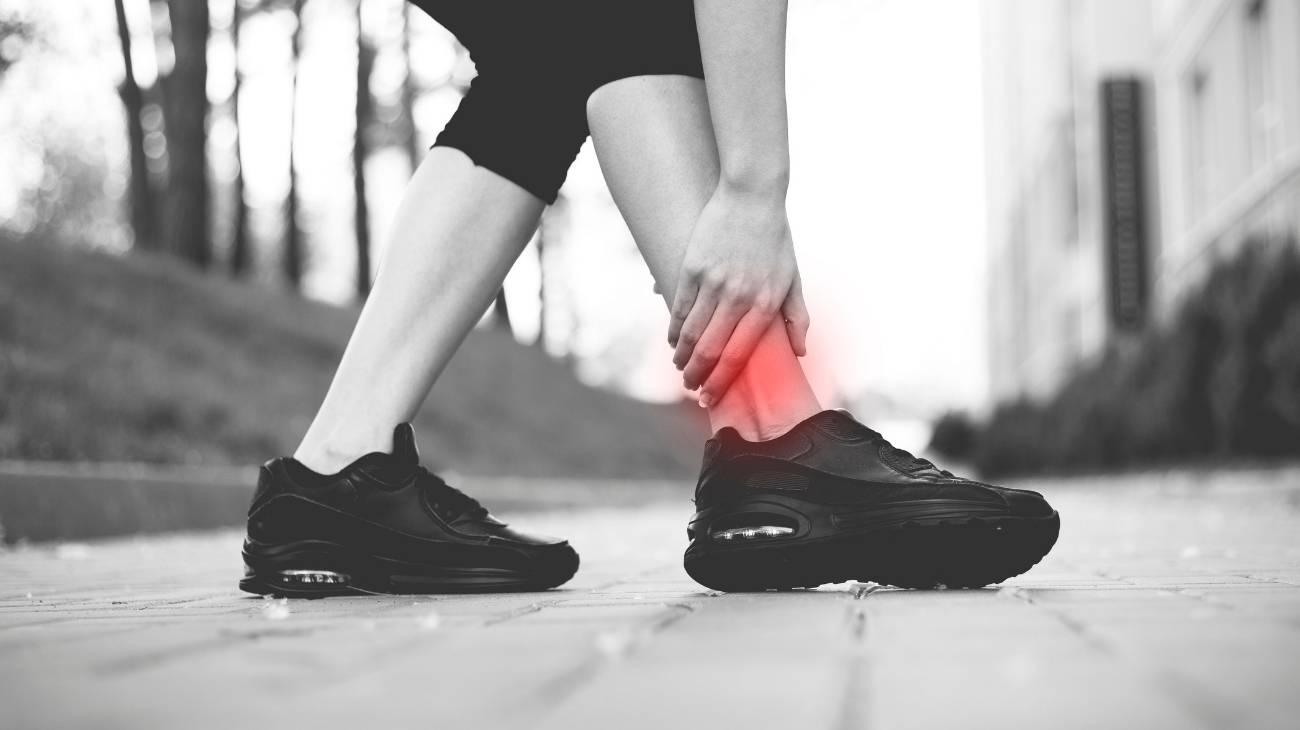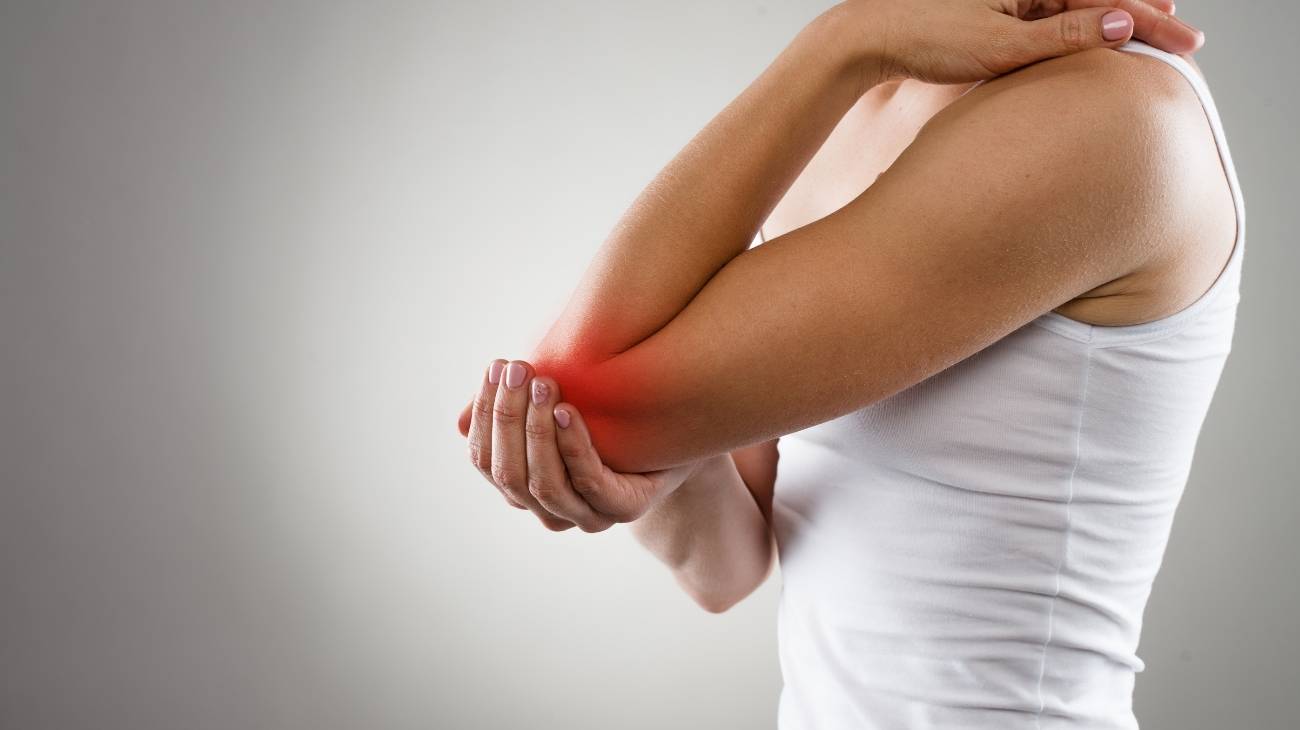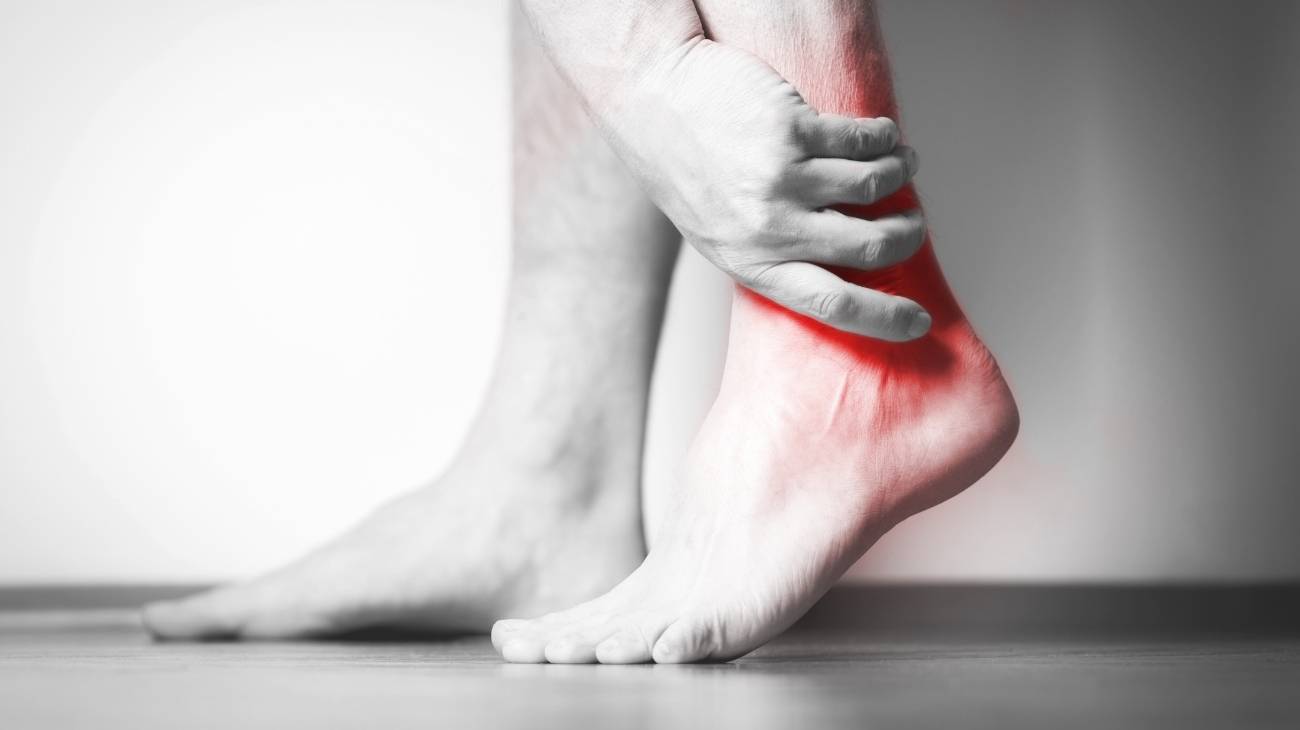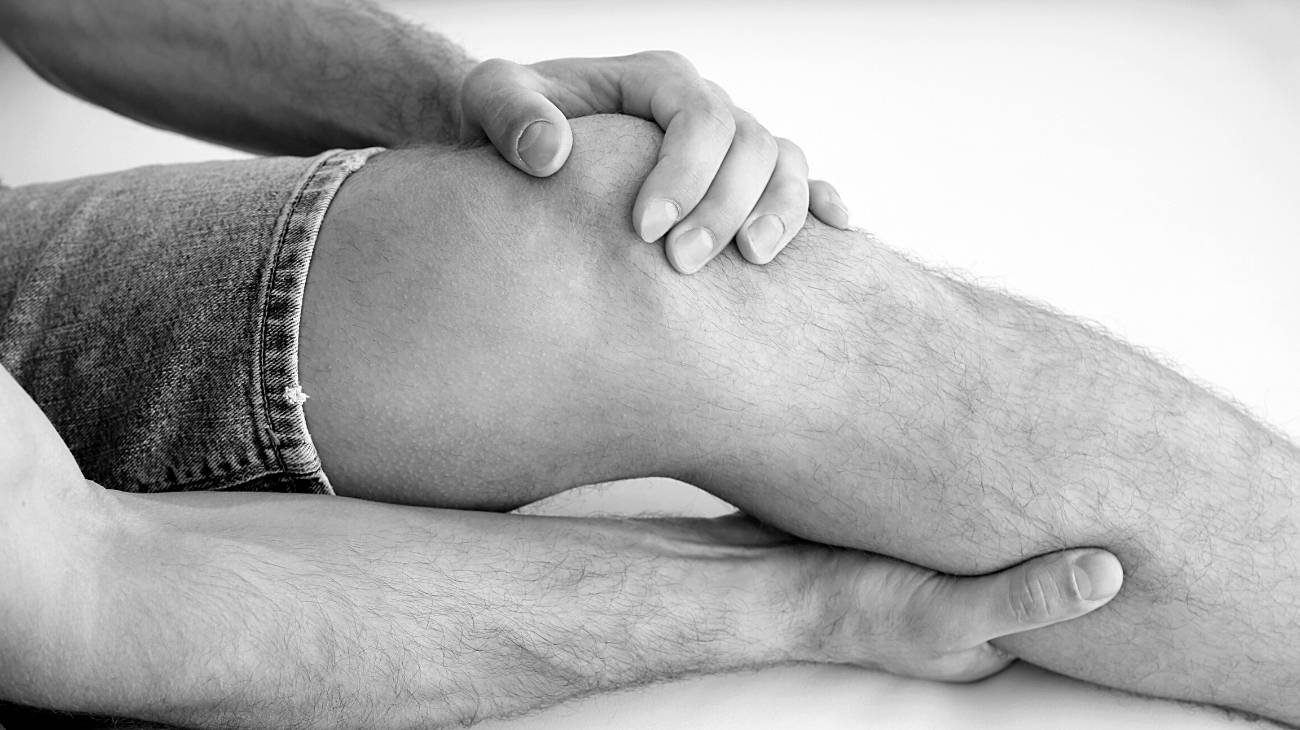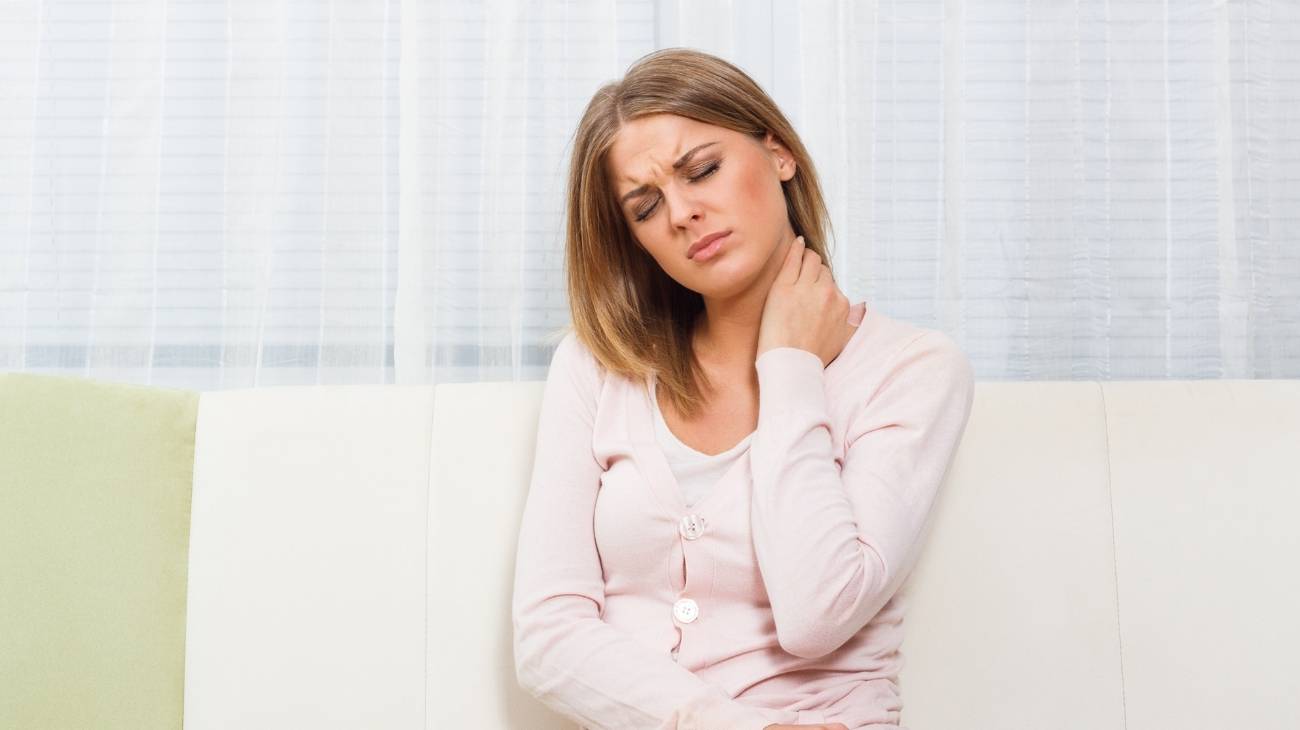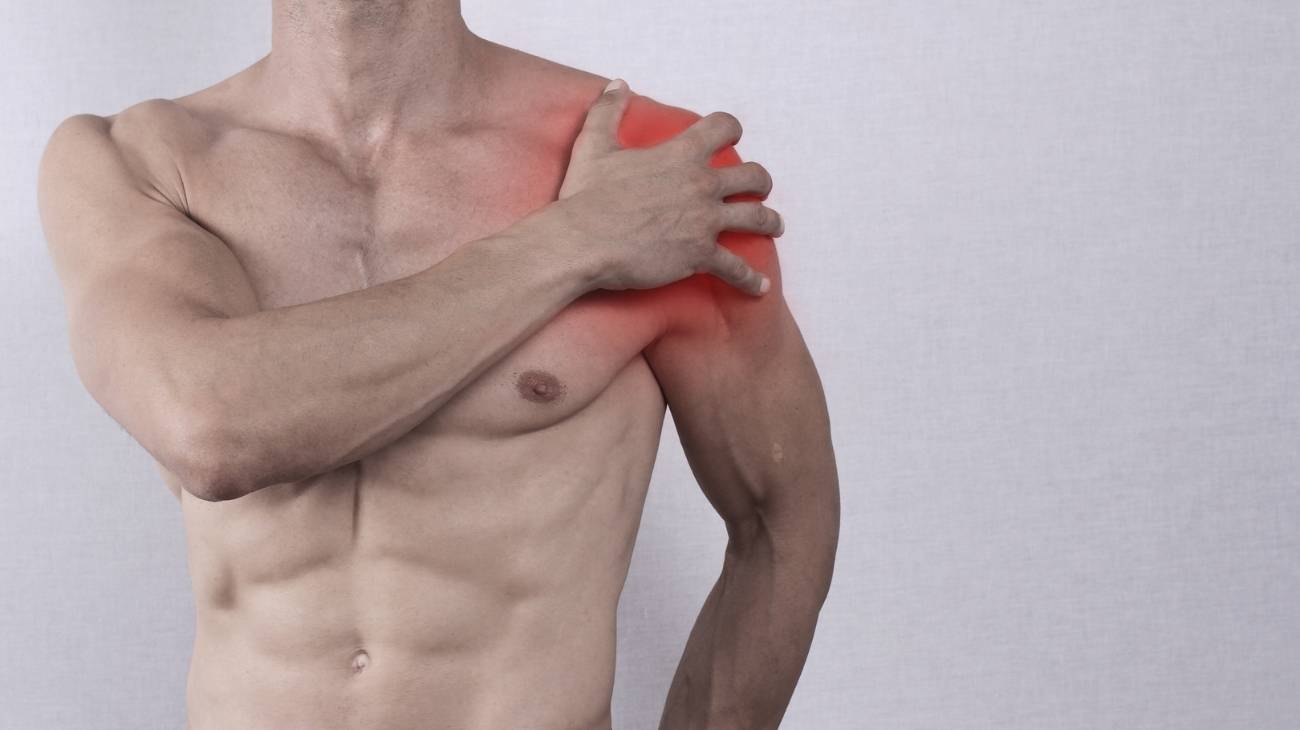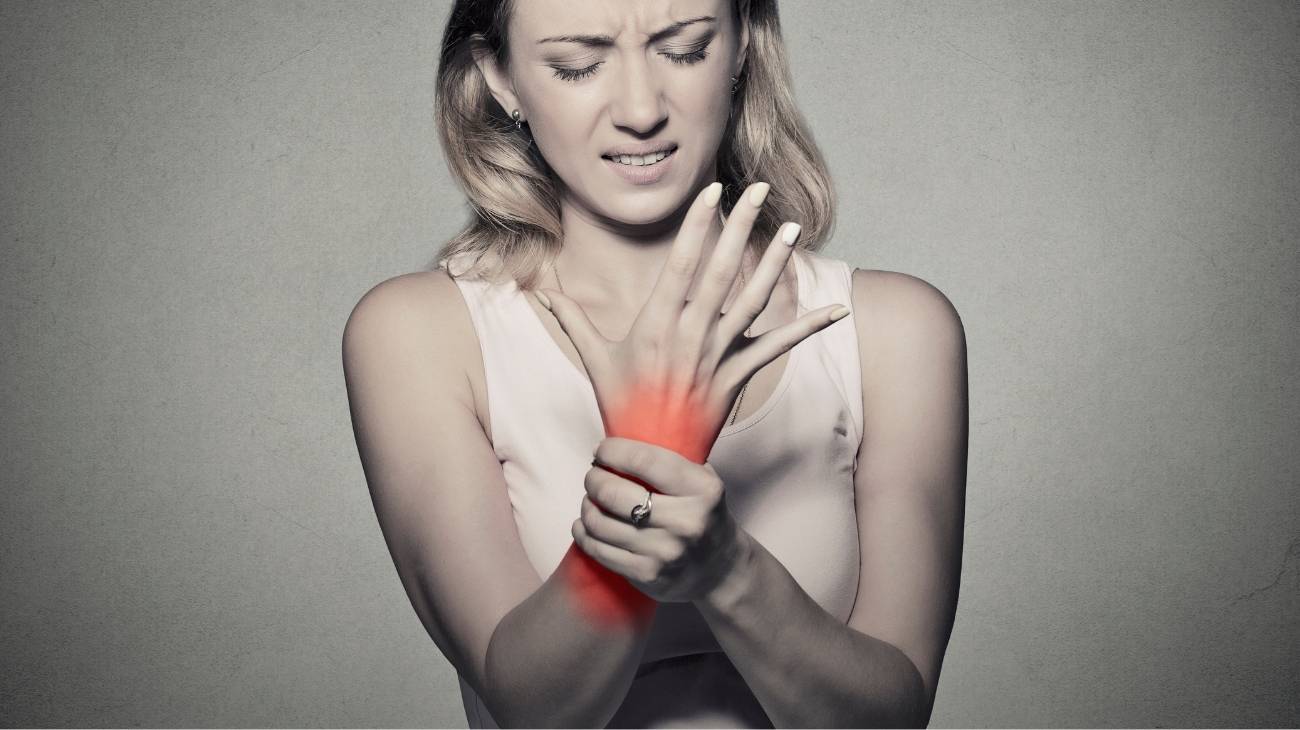- Definition: What is a sprain and what are its degrees?
- What are the most common types of sprains and strains depending on the area?
- Best sprains products
- What are the causes and risk factors for sprains and strains?
- Main symptoms that warn us that we have a sprain
- What treatments are available to improve the symptoms of a sprain?
- What are the most effective prevention methods for sprains?
- F.A.Q: Frequently Asked Questions
When the ligaments that support the bones are stretched more than normal or break, the joint becomes painful and inflamed, resulting in a sprain. This is a condition that triggers severe pain, along with joint stiffness and even a change in the colour of the skin in the affected area.
Now, although sprains can sometimes be mild, in other cases they are considered serious and therefore, there are three degrees of severity that characterise this ailment. You will learn about them below, as well as their types, causes and risk factors, symptoms, treatments and prevention methods.
Definition: What is a sprain and what are its degrees?
Also known as sprains are defined as a tear, stretch or injury to the ligaments that surround a joint or join two bones that form a joint. Typically, this condition is caused by excessive stretching by the patient or whenever a joint is placed in an abnormal position.
Basically, this is because ligaments are made up of fibres that, although they are very resistant, tend to rupture when they are forced to the limit or when they are impacted by a sudden movement. As a consequence, joint sprains cause great pain, as well as swelling and stiffness.
Taking into account that, depending on the discomfort that is triggered, there are three degrees of severity that classify sprains in medical terms and these are:
Grade 1
In this case, the ligaments or part of the ligaments are stretched, without causing tears or tearing of the ligaments with respect to the bone. Therefore, there is no associated joint laxity and, as a result, the patient will only have mild pain (with varying intensity) and a mild inflammatory process, as well as the possibility of full and/or normal movement.
Grade 2
This is a partial rupture of the ligamentous tissue. As a consequence, the pathological condition of the affected individual triggers intense pain accompanied by much more pronounced swelling compared to Grade 1 sprains. In addition to this, there are different levels of swelling and deformity or ecchymosis, which is why they are unable to move normally in the traumatised area.
Grade 3
This is the most serious degree of joint sprain of all. It leads to a complete rupture of the ligamentous portion, which includes a tearing of the bone connected to it. Because of this, the patient experiences severe pain, prominent swelling and accentuated deformity, as well as a functional significance of the joint that has received the tear. It is therefore amenable to surgical treatment in order to repair the injured ligament.
What are the most common types of sprains and strains depending on the area?
In addition to the classification according to the severity of the strain, at a medical level, there are also other typologies that have to do with the area affected by this ailment in the human body. That is why, in order to know more about the type of trauma in question, it is important to know which are all the ones that can occur and here, we mention them one by one:
Cervical sprain
It consists of a muscle strain in the neck that corresponds to a tear in one of the ligaments that connect the cervical vertebrae and, consequently, generates pain in the neck area. Normally, this kind of sprain is caused by sleeping in a position that distends the neck, carrying heavy objects on one side of the body, car accidents, blows to the head, etc.
Now, in order to recognise cervical sprain and not to confuse it with other similar conditions, it is essential to know which are its most relevant symptoms, and among them, the following are pointed out:
- Neck pain.
- Stiffness and pain when moving the neck.
- Predominantly suboccipital headache.
- Reflex paravertebral muscle contracture.
For its part, in this case, from 0 to 4 degrees of severity are managed to treat the ailment.
Shoulder sprain
As its name indicates, it is an injury that appears in the shoulder of the affected person. It occurs when a ligament connected to the shoulder area is torn. As a result, the ligamentous portion of the shoulder is partially or completely torn and the joint is tender to the touch and in severe pain. In addition, the person may experience an inability to raise, lower and rotate the arm, as well as changes in skin colour or bruising.
Shoulder sprain usually occurs among athletes, such as wrestlers, football and rugby players. It should be noted that, although it is not a very serious sprain, if the pain is severe and swelling starts to occur or symptoms do not improve within 5 to 7 days, it is important to see a specialist doctor for treatment or procedure.
Elbow sprain
This corresponds to an abnormal stretching of the ligaments that stabilise the elbow and, in effect, alters the functioning of this part of the arm. Ligaments are strong tissues that cross the joints and connect the bones to each other. Therefore, elbow sprains cause pain and stiffness, especially when there is movement.
Other symptoms of this type of injury include swelling and tenderness, reduced arm activity, and bruising that causes your skin to change in pain. They are usually triggered by direct blows to the elbow, falls on an outstretched arm, overuse of the elbow, twisting of the limb, weak joints, lack of coordination and imbalance.
Hand and wrist sprain
This is a ligamentous injury caused by traumatic elongation or strain of the fibres in the hands and wrists. In most cases, this condition is caused by a fall on the hand, repetitive strain or overexertion, as well as poor technique in sports (e.g. gymnasts, contact and strength athletes).
Thus, these hand injuries and what is known as "open wrist" cause the appearance of mechanical pain that increases in intensity with movement of the limb. Additionally, it generates a notable inflammation of the soft parts, loss of strength and even increased sensitivity in the impacted wrist or hand. To cure it, in most cases, the joint must be immobilised to prevent the injury from worsening.
Back sprains and dislocations
Also known as "lumbar sprain", this refers to trauma to the ligaments or muscle tendons located in the back or lumbar region. As such, it causes pain that can be moderate or severe, depending on the severity of the case. In addition, patients have difficulty sitting or standing and it is also a type of dislocation that limits movement and in some cases, extends the pain to the lower limbs.
The main causes of back sprain are as follows: Carrying a heavier load than the body is capable of carrying, a sedentary lifestyle or lack of physical exercise, sitting for a long time, making incorrect and repetitive movements, having a bad position when making physical effort, direct trauma to the lumbar spine (due to a blow, fall or accident) and pelvic torsion problem (feeling that one leg is shorter than the other).
Sprains of the leg and knee
A sprain or tear of the leg is defined as an injury that becomes externalised once the ligaments are strained beyond the limit of normal range. Likewise, a knee sprain is a trauma that occurs to one or more ligaments in the knee (there are four that make up the knee) and can be partial or complete. In both cases, if the sprain is mild, it can heal in 6 weeks and if it is severe, it will take up to 12 months for the patient to fully recover.
In terms of symptoms, people mainly suffer from joint pain or muscle pain, functional strength, decreased movement and stiffness, a noticeable swelling and change in skin pain (bruising) and instability when walking. This is triggered by a sudden increase in physical activity, improper stair climbing, not wearing comfortable footwear, accidents in which the patient slips and falls suddenly, etc.
Ankle and foot sprains
In this case, it consists of an injury to the external lateral ligament of the joint that occurs when the person bends, twists or turns the ankle in an abnormal way. This movement is rough and sudden, stretching or tearing the strong bands of tissue that hold the bones in the ankle together. Thus, depending on the severity of the sprain, a grade 1, 2 or 3 ankle sprain can be envisaged.
In this sense, the causes or risk factors that mostly trigger this type of sprain are: walking or doing physical activities on an uneven surface, having falls that bend the foot, a bad slope after turning or jumping, use of inappropriate footwear, practice of a sport in which it is necessary to change the direction of the feet quickly, the violent stepping of another person, etc.
Intercostal sprain
It is defined as a pathology that occurs in the intercostal area or in the space between the ribs. Thus, it consists of a sprain that causes strong punctures in this area of the body when the patient breathes deeply, gets out of bed, makes movements while lying down or extends the arm to pick up an object. This produces a very sharp transverse pain in the rib cage and generates discomfort in a part of the upper limb that can spread to the arm.
Among the most common reasons for this type of sprain in the human body, the following are recognised: flu with strong sneezing, direct blow to the ribs, forced torsion of the trunk, consecutive blocking of the dorsal vertebrae, posture problems and some diseases that cause difficulty in breathing. It is worth noting that this sprain can occur in people of any age and its severity depends on the cause.
Best sprains products
Bestseller
-
2 Elbow Compression Sleeve (Black/Gray)
£20,95 -
2 Elbow Compression Sleeve (Green/Navy)
£20,95 -
2 Elbow Compression Sleeve (Pink/Bordeaux)
£20,95 -
2 Knee Compression Sleeve (Green/Navy)
£20,95 -
Ice Pack for Foot - Cold Therapy Socks (Black)
£20,95 -
Ice Pack for Foot - Cold Therapy Socks (Green)
£20,95 -
Ice Pack for Foot - Cold Therapy Socks (Pink)
£20,95
-
2 Ankle Compression Sleeve (Black/Gray)
£20,95 -
2 Ankle Compression Sleeve (Green/Navy)
£20,95 -
2 Ankle Compression Sleeve (Pink/Bordeaux)
£20,95 -
2 Knee Compression Sleeve (Black/Gray)
£20,95 -
2 Knee Compression Sleeve (Pink/Bordeaux)
£20,95 -
Back Support Belt (Black)
£39,95 -
Back Support Belt (Green)
£39,95 -
Back Support Belt (Pink)
£39,95 -
Sacroiliac Support Belt (Black)
£24,95 -
Sacroiliac Support Belt (Green)
£24,95 -
Sacroiliac Support Belt (Pink)
£24,95 -
Shoulder Support Brace (Black)
£24,95 -
Shoulder Support Brace (Green)
£24,95 -
Shoulder Support Brace (Pink)
£24,95
What are the causes and risk factors for sprains and strains?
In general terms, sprains are caused when a joint exceeds the maximum permitted limit of movement. As a result, the ligament that covers the bones is stretched beyond its capacity to the point of distension, tearing and rupture.
Basically, these are:
- Sudden and/or excessive movements, especially when carrying a load, which increases the severity of the sprain.
- The fatigue or tiredness present in the muscles also stimulates the appearance of sprains. This does not provide good support for the joints and they tend to tighten up to the point of injury.
- Another common risk factor is environmental conditions. Uneven or slippery surfaces increase the likelihood of sprains.
- If trauma is present, sprains are also possible. This is usually caused by accidents or impacts to the joints.
- Wearing inappropriate footwear is considered another reason why people are at risk of sprains. Whether in the ankle and foot, knee or leg, for example.
- Prolonged immobilisation, which consists of a lack of physical exercise and contributes to a sedentary lifestyle, is known to cause sprains in different parts of the body. The joints become more vulnerable.
- Overweight people, in general, tend to sprain their knees and ankles.
- Another reason for these sprains is age. The older you get, the stiffer you get, the more stiffness there is, and therefore rough movements are not tolerated.
Main symptoms that warn us that we have a sprain
Depending on the degree of severity that sprains or strains can cause, there is a precise symptomatological picture from which it is possible to be sure that we are dealing with this type of injury, since it is often confused with other similar ailments.
It is of great importance to know which are the signs that warn of the manifestation of an ankle, foot, leg, knee, shoulder, elbow, cervical or intercostal sprain:
- Joint or muscle pain: This is undoubtedly the main symptom of this condition and is characterised by the fact that it remains constant due to the inflammation or partial rupture that is generated. The higher the degree of the sprain, the more severe the pain and it can even trigger a phenomenon of hypersensitivity (or intense pain at the slightest friction of the impacted joint).
- Edema or swelling of the tissues: Once the sprain manifests itself, the blood capillaries break and the synovial fluid of the injured joint accumulates in the joint capsule. As a result, the joint increases in size and exhibits a deformed appearance because the joints of the interlocking bones are displaced.
- Joint stiffness: This refers to a symptom that results in a loss of range of motion and in effect, causes a noticeable difficulty in moving the joint because it tends to feel achy. This is mainly caused by inflammation in the affected area.
- Limited or nullified functional instability: Another sign of a sprain or contracture is based on the impotence of the function of the joint section that causes the cessation of usual activities. As a result, the ligaments are damaged in such a way that they are no longer able to provide the usual strength. In the case of a sprained ankle or knee, this symptom results in the inability to walk.
- Bruising or ecchymosis: It is also possible that the swollen area caused by the sprain may bruise a few hours after the injury. This is because the impact ruptures a blood vessel and as a consequence, a reddish dotted area appears on the injured area. Therefore, as the condition disappears, the colour of the skin will change.
- Feeling of warmth in the damaged area: In some cases, the patient may feel warmth or an increase in temperature in the area that has been injured. As there is accumulation of blood in the joint area, this causes an increase in heat.
What treatments are available to improve the symptoms of a sprain?
Fortunately, there are numerous treatments and therapies that help to alleviate the discomfort caused by sprains. As a result, the symptoms and signs of the sprain can be minimised in a short period of time.
We highlight which alternative therapies are ideal for alleviating sprains, as well as the dietary supplements that contribute to their treatment, recommendations when it comes to medication and when it is appropriate to resort to surgery:
Alternative and complementary therapies
When it comes to curing the symptoms of sprains, there are some therapeutic techniques that are recommended to attack this condition in the right way.
Here, we mention what they are and let you know how they should be implemented:
- Heat and cold therapy: This is an optimal treatment that, using heat and cold, has the ability to moderate pain and inflammation in a certain area of the body. By increasing blood flow, it helps to alleviate the symptoms of a sprain. To perform it, the patient can use a hot gel pack with cold water or ice compresses and place it alternately where the injury occurred. This is done for 20 to 30 consecutive minutes.
- Compression therapy: Using an elastic product, this compressive therapy is a technique that focuses on exerting controlled pressure on a part of the body to reduce venous pressure and normalise the function of the vascular wall in order to improve blood flow and ameliorate any ailment. This is why patients with sprains are advised to undergo compressive bandaging of the injured area.
- Massage therapy: Naturally, massage is considered a good therapeutic technique for recovery, as it avoids the chronification of the pathological state of sprains and therefore accelerates recovery and the early return to normality of the affected joint. Taking into account that it also reduces inflammation, if performed by an expert. It should be noted that grade 2 and 3 sprains should be treated with circulatory massage of the residual oedema.
- Acupressure therapy: Traditional Chinese medicine has proposed this type of therapy, which basically uses pressure exerted with the fingers and elbows on certain areas of the human body to stimulate certain strategic points (organs, emotions and feelings) that help to soothe ailments. In the case of sprains, one of the alternatives used is acupuncture with filiform needles on the main points (located in the injured area) and auxiliary points (located at the ends along the meridians).
- Thermotherapy: This is a treatment used to treat inflammation, soothe muscle spasms and improve certain injuries such as sprains. It uses heat with the aim of providing an anti-inflammatory, analgesic and sedative effect, since, with a temperature higher than that of the patient's body, it manages to increase blood flow and guarantees flexibility to the connective tissue. To do this, the expert must apply heat to the affected area for sessions of between 10 and 30 minutes (depending on the technique used and the area to be improved).
- Natural remedies using plants: People who have this ailment can also resort to natural remedies based on plants that help to soothe the discomfort and deflate the part where the sprain was generated, in order to accelerate healing. Thus, among the natural treatments recommended are: drinking two cups of horsetail tea, applying arnica to the painful area, using thyme as an essential oil to place on the skin, preparing cayenne pepper tea and consuming it twice a day, crushing a clove of garlic and mixing it with two tablespoons of coconut oil and applying it with gentle massages to the impacted region.
- Healthy lifestyle habits: A useful formula to attenuate the pain caused by sprains and even to avoid this ailment is to acquire healthy habits that allow the body to hinder the onset of this pathology and also prevent the development of these sprains. For example, you can implement the following: Exercise gradually to avoid a sedentary lifestyle, stretch properly and warm up before doing any sport, wear the right shoes that fit your feet well, stop training in unfamiliar sports to reduce the risk of sprains.
Nutritional supplements
In general, it is important for people to have a healthy diet to help the body to function properly and avoid suffering alterations that trigger certain pathologies. However, in addition to this, it is also essential that this diet is combined with some dietary supplements that increase the optimisation of the functions of each part of the body.
This is because these food supplements are characterised by providing good quantities of vitamins, minerals, enzymes, fatty acids and amino acids.
Food supplements are recommended in conjunction with a balanced diet:
- Magnesium: It is an electrolyte that is responsible for regulating the functioning of the muscular system and, thanks to its good levels in the body , it minimises osteoarthritis and bone decalcification (especially magnesium chloride), it is considered a recommended mineral to avoid sprains and breaks. Some foods rich in magnesium are the following: avocado, spinach, nuts, quinoa, lentils, chickpeas, dark chocolate, whole wheat, etc.
- Vitamin C: While it is true, this vitamin plays an important role in the formation of collagen which is substantial for flexibility and strength; thanks to this, it helps to optimise the health of tendons and ligaments, as well as strengthen bones. It is therefore a good dietary supplement for treating sprains and/or injuries in the human body. To ingest vitamin C, you can resort to: citrus fruits (orange, kiwi and grapefruit, for example), as well as strawberry, papaya, pineapple, melon, tomato, red and green peppers, spinach, potatoes, peas, etc.
- Omega 3: This is a fatty acid that is essential for relieving inflammation around the joints and is therefore known for its anti-inflammatory effect. Consequently, it is considered an ideal oil for healing sprains and improving joints. Some foods rich in omega 3 are: oily fish, eggs, milk, yoghurt, walnuts, flaxseed, olive, canola, linseed or soybean oil.
- B-complex vitamins: This group of vitamins has been instrumental in helping the body maintain efficiency in the joints, heart, digestion, skin and nervous system by helping the body use fats and proteins skilfully. Thus, vitamin B3 in particular has anti-inflammatory properties that improve symptoms associated with sprains or certain joint pathologies. It is therefore recommended to eat foods rich in vitamin B3, such as: fish (tuna, anchovies, swordfish, etc.), white meat (especially chicken or turkey), rice and wheat bran, peanuts, paprika, green vegetables, milk, eggs and more.
Medications
In most cases, when patients with this condition report that the pain has increased markedly, the inflammation is getting worse and worse and does not go away after two days, in addition to certain therapies or recommendations, they also resort to taking over-the-counter pain medication.
However, at the medical level, self-medication is not recommended because it can lead to serious side effects such as dizziness, fainting, nausea, diarrhoea, drowsiness, dependence, addiction and even cardiac arrest. Therefore, in these cases, patients are advised to visit a medical specialist who will study the incident in detail in order to provide a clear and concise diagnosis.
Based on certain manoeuvres to explore the degree of involvement of the ligamentous apparatus, he or she will be able to indicate treatment with the appropriate medication and/or therapies. He or she will also assess the person's tolerance to medication, medical history, age, state of health, degree of limitation of joint mobility and other essential aspects.
It is also worth noting that in order to visualise the structures and tissues damaged in a sprain, it is not appropriate to perform an X-ray. Rather, joint ultrasound is considered to be very useful for this type of injury because it provides information about the rupture of the ligaments affected by the sprain. In addition, in some cases or when there is a bad evolution, doctors have to resort to magnetic resonance imaging (MRI). In very exceptional cases, they may even have to subject the patient to a joint puncture to extract and analyse the fluid present.
Surgery
In very severe cases, especially when a grade 3 sprain is present, surgical treatment is appropriate to repair the affected ligament. Because people who suffer this type of sprain have a complete rupture of the ligamentous tissue and, as a result, the patient is unable to rest on the joint. Therefore, in order to cure it completely, it is essential to carry out surgery with the appropriate prior preparation.
What are the most effective prevention methods for sprains?
Fortunately, just as there are ways to ease the pain and discomfort of a sprain, it is also possible for people to avoid sprains by taking into account the most effective prevention methods known.
To help prevent the occurrence of sprains or strains, we recommend the following:
- Maintaining regular and healthy physical activity that is done gradually is one of the main techniques to avoid sprains. A sedentary lifestyle is considered a risk factor for this pathology.
- Just as it is important to exercise, it is also essential that people warm up before practising sports. Otherwise, the ligaments will be more susceptible to sprains or injuries.
- In addition, when doing any sport or physical activity, it is advisable to use elements or devices that exert adequate pressure on the ankle or other joints that you have to move.
- Proprioceptive training is considered a key method to avoid the appearance of this ailment. This basically consists of preparing the body by working on coordination and strength, in order to avoid a sudden impact on the ligaments. Thus, for example, in the case of the feet, this training helps to know how to step correctly depending on the surface.
- Another way to avoid sprains is to wear the right footwear. This, above all, must fit the foot correctly and/or exert the right amount of tension. In addition, it is recommended that women avoid wearing high heels that increase the risk of lower limb sprains.
- As far as possible, supination and pronation of the foot should be avoided. This is the external rotation of the foot when it comes into contact with the ground (supination) and the movement of the foot when it is in contact with the ground and rotates inwards (pronation). This tends to lead to sprains or associated injuries.
- Also opt out of sports or activities for which you have not previously trained. Ignorance of their correct execution increases the vulnerability of contracting a tear or abnormal stretching of the ligaments.
F.A.Q: Frequently Asked Questions
Despite the fact that sprains are very common pathologies in any of their types, there are still many people today who have doubts about this ailment:
References
- Nitz, A. J., Dobner, J. J., & Kersey, D. (1985). Nerve injury and grades II and III ankle sprains. The American journal of sports medicine, 13(3), 177-182. https://journals.sagepub.com/doi/abs/10.1177/036354658501300306
- Derscheid, G. L., & Garrick, J. G. (1981). Medial collateral ligament injuries in football: nonoperative management of grade I and grade II sprains. The American Journal of Sports Medicine, 9(6), 365-368. https://journals.sagepub.com/doi/abs/10.1177/036354658100900605
- Thompson, C., Kelsberg, G., & St Anna, L. (2003). Heat or ice for acute ankle sprain?. https://mospace.umsystem.edu/xmlui/handle/10355/2939
- Nunley, J. A., & Vertullo, C. J. (2002). Classification, investigation, and management of midfoot sprains: Lisfranc injuries in the athlete. The American journal of sports medicine, 30(6), 871-878. https://journals.sagepub.com/doi/abs/10.1177/03635465020300061901
- Roach, C. J., Haley, C. A., Cameron, K. L., Pallis, M., Svoboda, S. J., & Owens, B. D. (2014). The epidemiology of medial collateral ligament sprains in young athletes. The American journal of sports medicine, 42(5), 1103-1109. https://journals.sagepub.com/doi/abs/10.1177/0363546514524524
- Choi, B. C., Levitsky, M., Lloyd, R. D., & Stones, I. M. (1996). Patterns and risk factors for sprains and strains in Ontario, Canada 1990: An analysis of the workplace health and safety agency data base. Journal of Occupational and environmental Medicine, 379-389. https://www.jstor.org/stable/44994696
- Vicenzino, B., Paungmali, A., & Teys, P. (2007). Mulligan's mobilization-with-movement, positional faults and pain relief: current concepts from a critical review of literature. Manual therapy, 12(2), 98-108. https://www.sciencedirect.com/science/article/abs/pii/S1356689X06001226
- Smith, R. W., & Reischl, S. F. (1986). Treatment of ankle sprains in young athletes. The American journal of sports medicine, 14(6), 465-471. https://journals.sagepub.com/doi/abs/10.1177/036354658601400606
- Pellow, J. E., & Brantingham, J. W. (2001). The efficacy of adjusting the ankle in the treatment of subacute and chronic grade I and grade II ankle inversion sprains. Journal of manipulative and physiological therapeutics, 24(1), 17-24. https://www.sciencedirect.com/science/article/abs/pii/S0161475401844961
- Petersen, W., Rembitzki, I. V., Koppenburg, A. G., Ellermann, A., Liebau, C., Brüggemann, G. P., & Best, R. (2013). Treatment of acute ankle ligament injuries: a systematic review. Archives of orthopaedic and trauma surgery, 133, 1129-1141. https://link.springer.com/article/10.1007/s00402-013-1742-5

